By chance I fell over this quite amusing image of how London would be if it were like Venice. I believe it is a piece of very early science fiction writing, in the British scientific romance genre. It was published in 1899, and later republished on the Forgotten Futures web site.
Click on the link below for the full article and many more images of how London would have been, had it been like Venice.
If London Were Like Venice
Oh! That It Were!
by Signor Somers L. Summers
From Harmsworth’s Magazine, August 1899
Illustrated by Messrs. R. Thiele and Co.
“Geologists say that the land upon which London is built has subsided 68 feet during the last 500 years. This doubtless is traceable to substratiform deposits, lunar attraction, or causes equally occult; but whatever it is, the figures 68 disarm suspicion. Assuming that the subsidence is still going on, one can imagine the metropolis some day sinking below Thames level and becoming a second Venice” — Daily Paper.
BUT didn’t you know?” asked my travelling companion.
“No!” I answered. “You see, I left England away back in ’99, and I have been virtually cut off from civilisation ever since. In Siberia the reading of newspapers is not encouraged, and letters, even if you have friends at home to write them, have a way of going astray unrivalled in any other country. Until I landed in Hull this morning, I had not had occasion to use the English language for years. So it is little wonder that what you say is surprising news to me.”
” Quite so,” continued the affable gentleman with whom I shared the first-class carriage, ” though we have grown so used to it by this time that we almost forget London ever existed in any other form. Let me see, it must have been in 1910 — the year of the floods — that the last subsidence occurred. It would have come about naturally in time, geologists said, but the climax was certainly precipitated by the Government’s action in allowing London to be undermined to such an extent when the new coal fields were discovered under the city in 1900. We had been steadily raising the embankments of the Thames, but the floods swept these away, and one morning we awoke to find our streets converted into waterways. All manner of remedies were tried, including a Royal Commission, which, by the way, decided only last week that nothing could be done, thus endorsing the public opinion of fifteen years ago. Of course the lower stories of all houses had to be abandoned, save as diving baths, but it was a simple matter to add others. Naturally the old street traffic almost vanished, cabs, ‘buses, and carts giving place to gondolas and steamboats. To begin with, we had to import gondoliers from Venice, to instruct our late cabdrivers in their new craft, at the same time adopting many other features peculiar to the Bride of the Adriatic. These, as you can imagine, have had considerable influence on our customs, our architecture, and even our language. English is still largely spoken, however.
Hullo ! we’ve arrived. ‘Stazione di Pancras’ I think that gendarme called — formerly known as St. Pancras, if I remember rightly.
“Come! hand your bags to the servitori, and let me introduce you to the new London, the Bride di Middlesex, as we proudly term our city. You will stop at the Hotel Cecil, on the Canale, I presume. We shall find gondolas at the other side of this piazza.”
Somewhat bewildered, I alighted from the train and followed my friend, having heard him instruct a cut-throat looking ruffian regarding my luggage in a jargon I could not understand. He led the way across a large paved space on to a kind of quay. What he had described was true.
At our feet stretched a shimmering sheet of water, its surface, in our immediate vicinity, black with countless gondolas, the men standing up in them clamouring loudly for custom. My companion beckoned, and a score glided up as though we had pulled as many strings. Entering one, we took our seats in the cool shade of the awning. “Lago di Hyde, Canale del Regente, Lago di Piccadilly, Croce di Charing, and Grand Canal,” called my friend, and away we sped.
I was dumb with amazement. The dull roar of traffic that I had always associated with London streets had vanished as though it had never been. Save for the rhythmical splash of the oars and the low musical voices of the gondoliers as they passed each other or approached a turning all was silent as the grave.
Here a prosperous city man, I knew the type — he carried his little basket of fish as of yore — was being whisked off to his suburban home in a fussy little steam affair; there a vision of olive-skinned loveliness, peeping coyly out from behind a fan, flitted past us all too fleetly; now the canals were so broad that even loitering Carter Paterson barges could not impede our passage; now they were so narrow that two gondolas could hardly pass abreast. The houses, flower-decked and sun-kissed, had nothing in common with the houses of my day, though many of them I knew must be the same. The ladies, sipping tea on balconies or tuning mandolins at open windows, seemed more daintily clad than any I had even seen before. Presently we passed beneath an arch that struck me as being familiar, and entered upon a vast expanse of water dotted with islets. Hundreds of other gondolas preceded and followed us. I looked at my guide inquiringly.
“This,” said he, “is the Lago di Hyde, Hyde Park that was in the dull old days, now the only place of its kind in the world. On the largest of the leafy islands that you see, bands play every afternoon and evening, and hither flocks all London — society in its private gondolas, and the people in personally-paddled parties at ten centesimi per head. Over there, that double line of posts marks what was once, I recollect, styled the Row. Tradition dies hard, and here fashionable men and maidens still take exercise in the early morning, now on water bicycles and water skates.”
On we went, threading our way between the islets and through many a quiet side canal, emerging at length into what was introduced to me as the Canale del Regente, but which I recognised as the Regent Street of old, and now undoubtedly rendered one of the most picturesque thoroughfares in the world. This in turn led to the Lago di Piccadilly (once Piccadilly Circus), from which we glided down the Rio di Haymarket, past the Teatro di Her Majesty, into surroundings that strangely recalled Trafalgar Square.
There were the lions, as of yore, save that they seemed to have developed wings, while on the north side was the old National Gallery, though my friend insisted on referring to it as the “Accademia delle belle Arti.” Nelson’s Column, I was glad to see, had been left alone. Leaving the Lago di Trafalgar we presently reached a much broader waterway than I had yet seen. Sheer out of it on one side rose the Houses of Parliament.
“The Canalazzo, or Grand Canal,” explained my companion, “formerly the Thames, Here are held all the water sports and races. This year America is sending over a gondola to compete for the London Cup against Conte Lipton.”
The next landmark recognisable to me was Somerset House, now styled, I learned, the Palazzo or Palace of the Doges; and then I saw the splendid Palazzo of the London County Council, from here being issued all regulations regarding the hours for bathing and the muzzling of the larger kinds of fish.
I had noticed that all the gondolas we had seen were painted black, only the ‘buses and other public vehicles boasted vivid colouring. In Old Venice, I recollected, during the fifteenth century a decree was issued ordering all floating things into mourning, the object being to favour espionage and political intrigue. In a black gondola on a black night the spies of the Government might travel anywhere without fear of detection. Only to ambassadors was given the privilege of decorating their gondolas in colours, and this in order that their movements might be the more easily followed. Some such edict had gone forth in London I concluded.
“The Council of Doges certainly did try something of the sort,” returned my guide in answer to my query, “though not with any great success. In the case of the gondola it wasn’t necessary. The Englishman who can afford to paddle alone is naturally of a sombre disposition, and would no more ride in a gaudy gondola than he would have patronised a yellow cab in the olden times. And as far as the ‘buses were concerned, the Doges’ decrees were as abortive as their attempts to restrict the language of the gondoliers, which, under stress of circumstances, remains a bright crimson as of yore.”
Anyone who has ever lingered in the vicinity of a canal must have realised what a marvellous influence such waterways have upon the rhetoric of skippers. Across the Rio at this moment was wafted to us the sound of voices–those of rival gondoliers holding sweet converse.
“Ten cents all the way to the Banco,” crooned one. “‘Igher up, there! ‘Ave ye bought the whole canal, Marco Giovanni ? Not so much splashing, Corpo Paolo, or I’ll smash yer bulkheads.”
“Garn,” replied the gondolier of a dazzling turn-out in green and gold — obviously a pirate –” I paddled a ‘bus before you eat yer first hokey. Git ‘ome to bed.”
With this pleasantry ringing in our ear we passed under what was pointed out to me as the Bridge of Sighs, but which looked suspiciously like the old Tower Bridge. Now we turned, and ere long we were in another spot familiar to me.
“Here,” said my friend, “you see the Palazzo di Royal Exchange, the Banco, and the Palazzo di Mansion House.”
“The Lord Mayor’s Show,” said I, “must be wonderful in these days.”
“Ah, yes; but you should say ‘carnival,’ and the head of the city is now known as the ‘Syndic’ — not Lord Mayor. It was suggested in some quarters that ‘syndicate’ would be more in keeping with the trend of the times.”
It was growing dusk now, but the most wonderful sight was yet to come. St. Paul’s, rising gaunt and spectral from its aqueous bed, the moon glinting on the lapping waters, the grateful silence, the quaint shadows that followed us down what was once Ludgate Hill, these things painted a memory-picture that will never fade.
One thing was puzzling me as we glided through the Rialto in what was formerly the Strand.
“Has cricket died out in London?” I asked.
“By no means,” was the reply; “on the other hand, we have improved it vastly, thanks to the introduction of water skates and floating wickets, and certainly rendered it far more exciting. I think we shall beat the Australians at the Lago di Lord’s to-morrow. It was very sad; their best bowler slipped on an oil patch and was drowned while playing at the Lago di Oval last week.”
I was not sorry when, shortly after, the gondola stopped at the Hotel di Cecil, and I stood on terra firma again. As I alighted the gondolier broke forth into song.
“Gondolieri drinka beera,” he chanted.
“What means he?” I asked.
“In the picturesque language of his class,” explained my fellow voyager,” he indicates that he will be glad to drink your health.”
” I will throw the lazzarone a lira,” said I, beginning to catch the atmosphere of the place.
* * * * *
“I think he’ll do,” someone said.
I sat up and gasped, “Is it out?”
I was in a dentist’s chair, recovering from gas — an overdose, I think. Even a normal amount induces strange dreams. My hands clutched a newspaper, and as I glanced at it my eye again caught the paragraph, ” Geologists say that the land upon which London,” etc.
Our photographs are by Messrs. R. Thiele and Co.
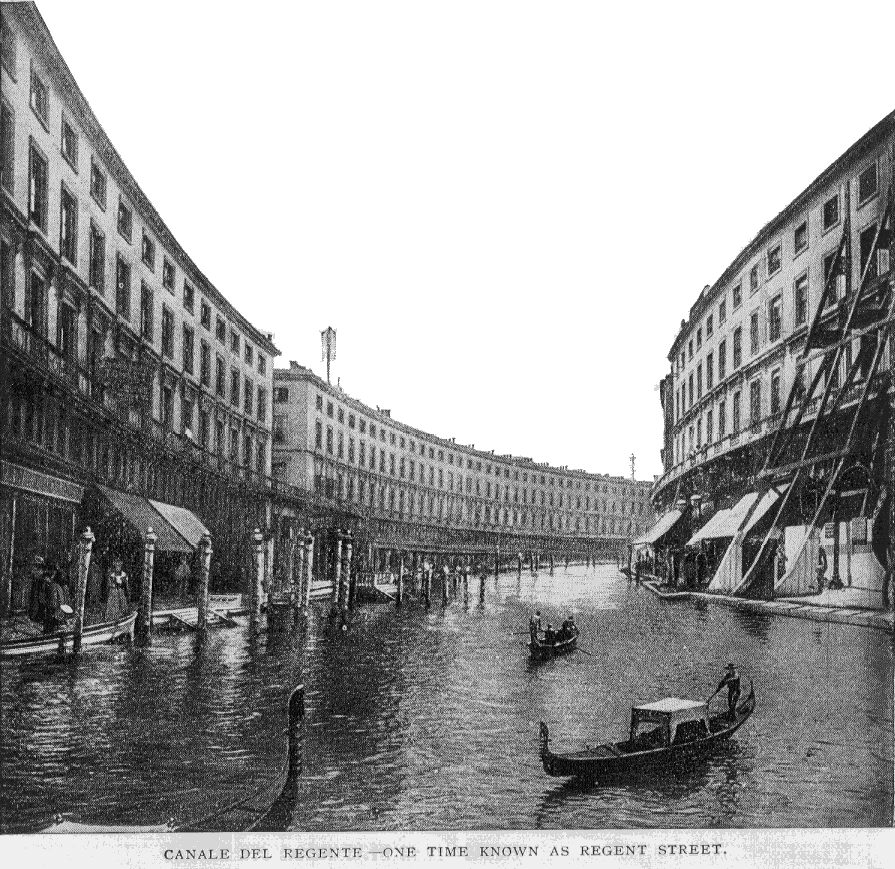
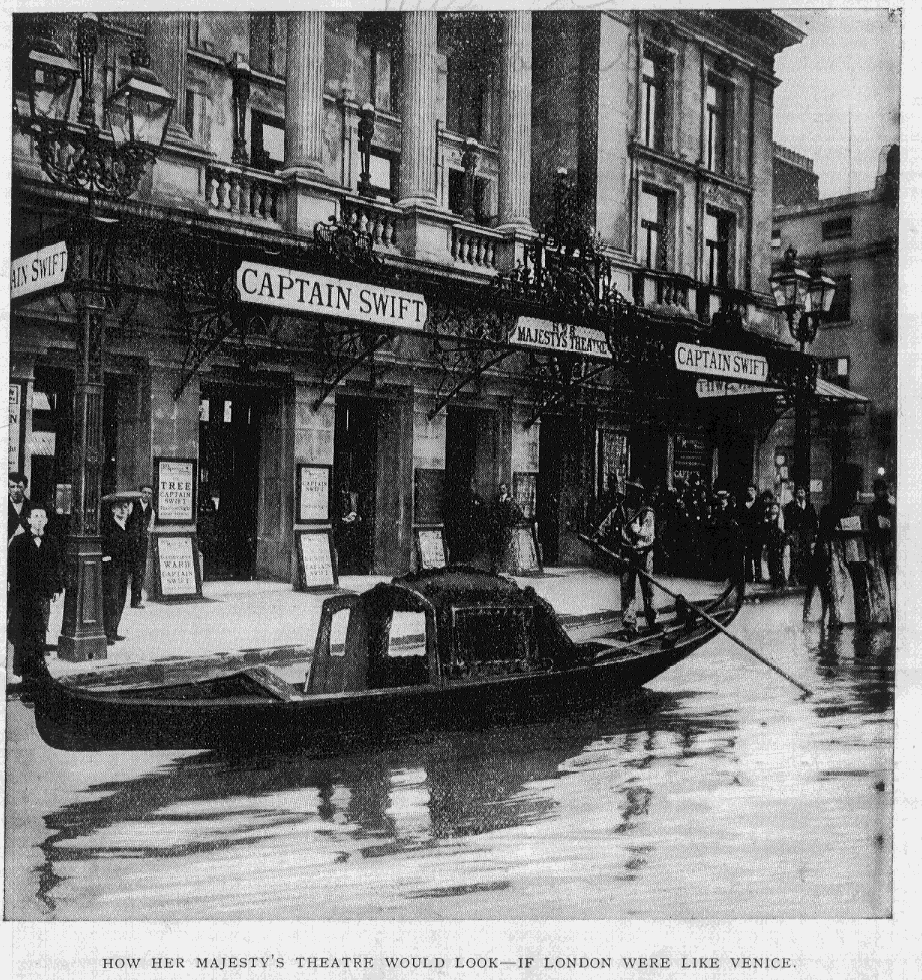
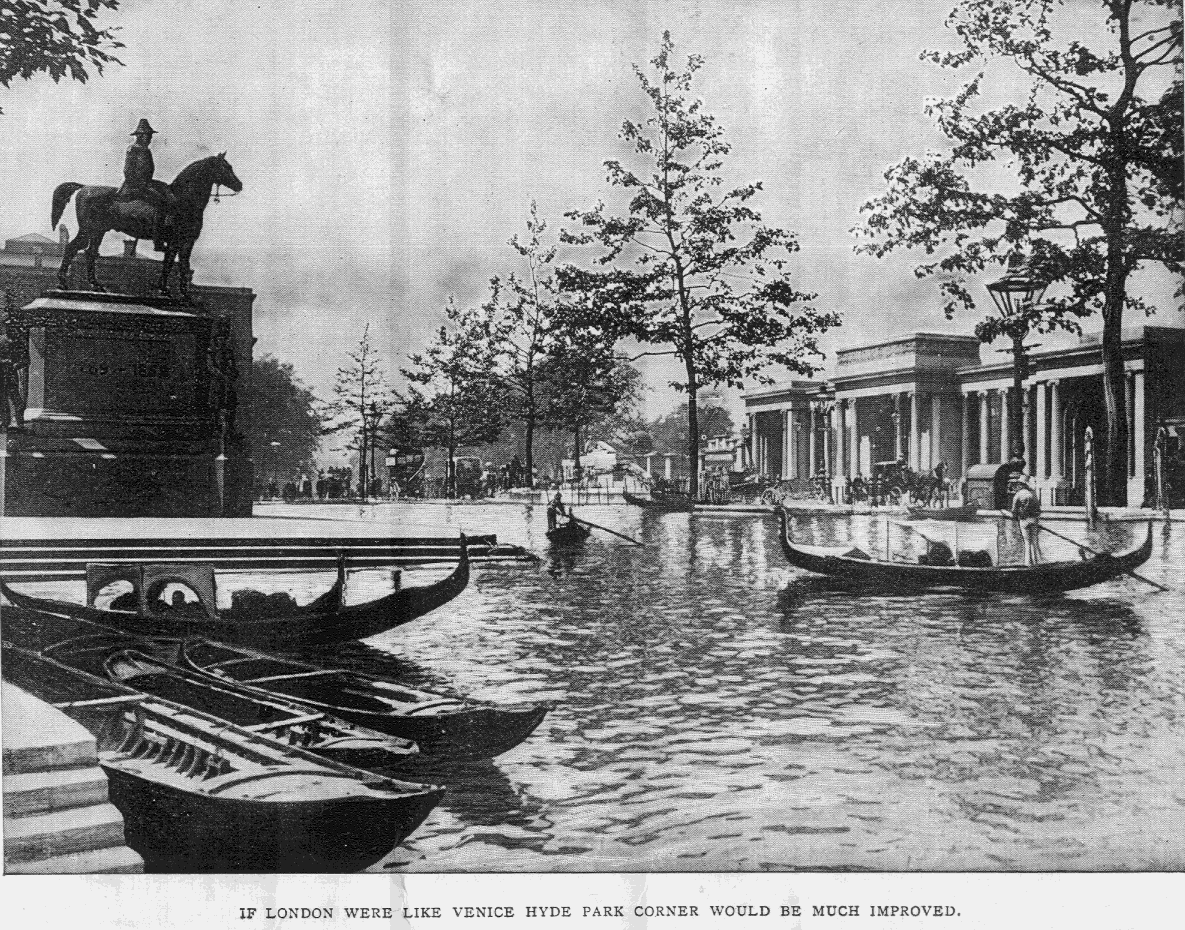
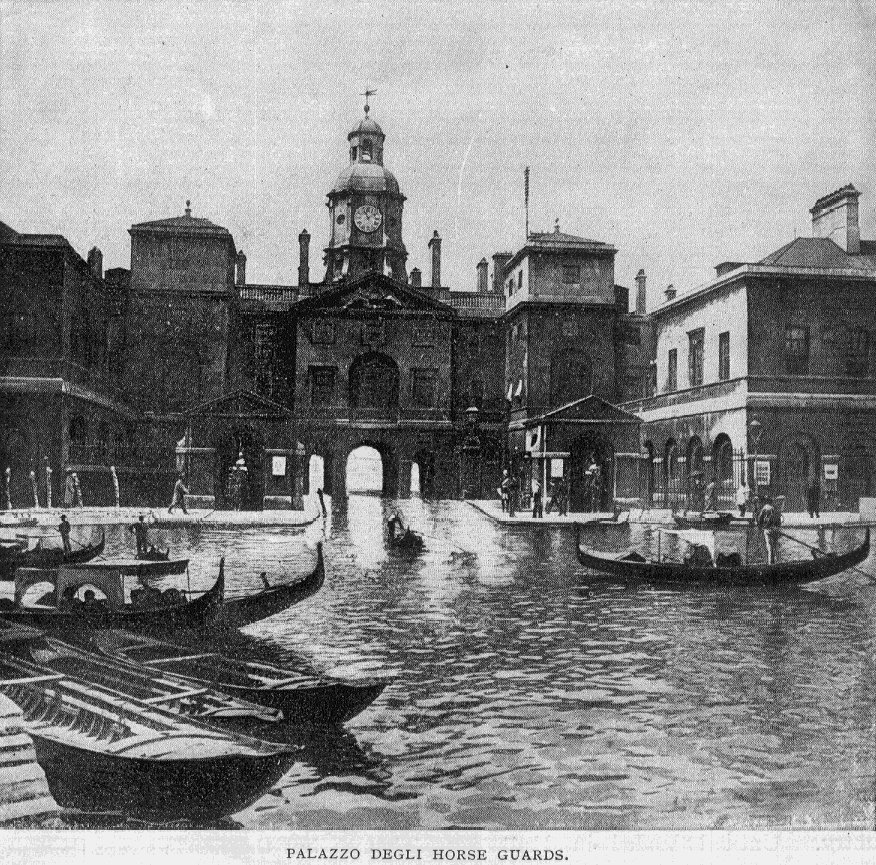


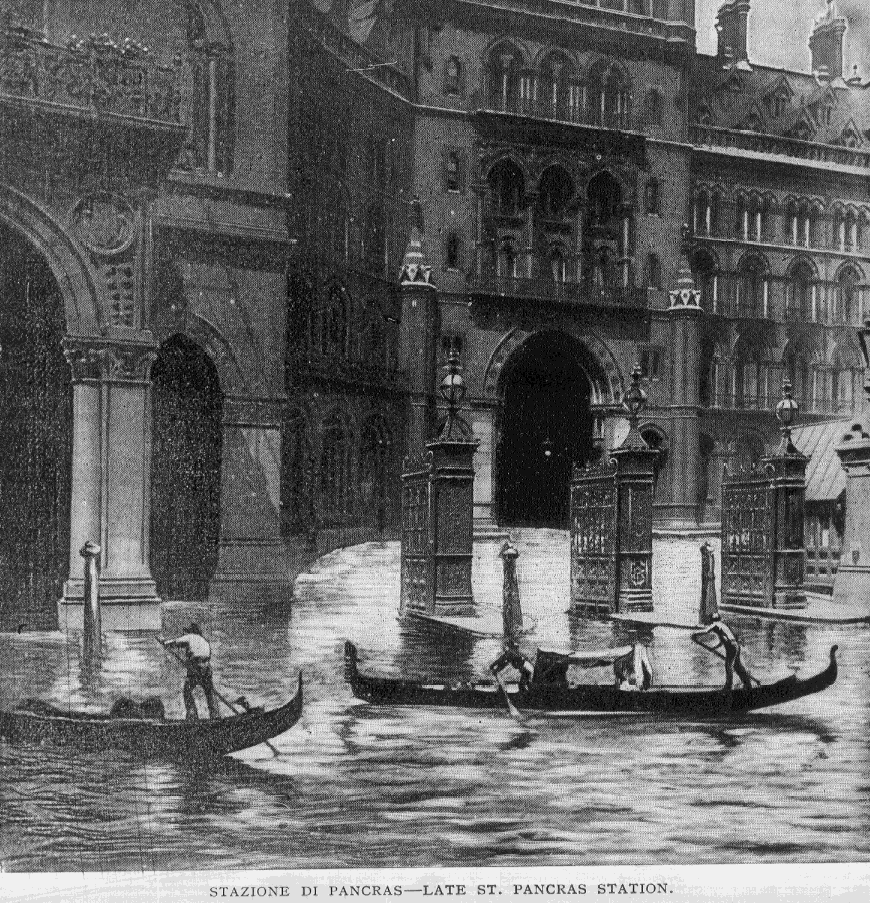
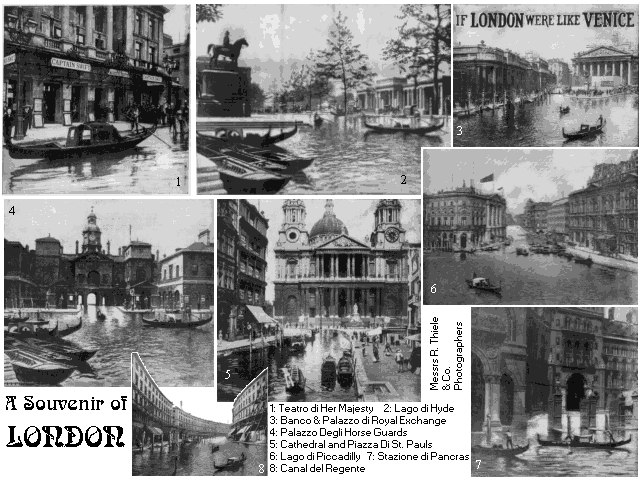
Leave a Reply